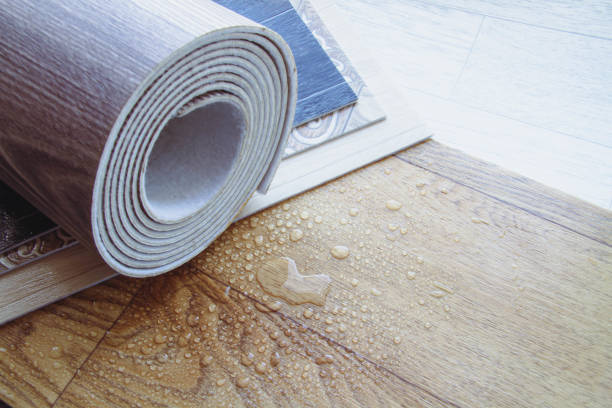When it comes to flooring options, vinyl flooring sheets have gained immense popularity due to their versatility, durability, and aesthetic appeal. They offer a wide range of design options while being cost-effective and easy to maintain. However, in order to truly create a safe and secure environment, it is crucial to prioritize floor safety with vinyl flooring sheets. In this comprehensive guide, we will explore various aspects of floor safety, including maintenance tips, slip resistance, installation considerations, and more. Whether you are a homeowner or a business owner, this article will provide you with the necessary insights to ensure the well-being of everyone who steps foot on your vinyl flooring.
Page Contents
Why is Floor Safety Important with Vinyl Flooring Sheets?
Floor safety is a crucial aspect of any environment, whether residential or commercial. With vinyl flooring sheets, it is essential to maintain a safe surface that minimizes the risk of slips, trips, and falls. Ensuring floor safety not only protects individuals from injuries but also reduces liability for property owners. By prioritizing floor safety, you create a welcoming and secure space for everyone.
Understanding Slip Resistance
Slip resistance is a key consideration when it comes to floor safety with vinyl flooring sheets. Slip accidents can result in serious injuries, and the slip resistance of the flooring plays a significant role in preventing such incidents. Vinyl flooring sheets are available in different slip resistance ratings, usually indicated by the manufacturer. The most common rating systems include the Ramp Test (R-Value) and the Static Coefficient of Friction (SCOF). These tests measure the frictional force between the shoe sole and the flooring surface, providing valuable information about slip resistance.
Maintenance Tips for Vinyl Flooring
To ensure floor safety with vinyl flooring sheets, proper maintenance is essential. Here are some practical tips to keep your vinyl flooring in optimal condition:
- Regular Cleaning: Sweep or vacuum the floor regularly to remove dirt and debris.
- Avoid Harsh Chemicals: Use mild cleaning solutions specifically designed for vinyl flooring.
- Promptly Wipe Spills: Clean up spills immediately to prevent slip hazards and stains.
- Protective Floor Mats: Place floor mats at entry points to trap dirt and moisture, reducing the risk of slips.
- Furniture Pads: Attach felt or rubber pads to the bottom of furniture legs to prevent scratches and scuffs.
- Avoid High Heels: Discourage walking on vinyl flooring with high heels, as they can cause indentations and damage.
Installation Considerations for Floor Safety
Proper installation is crucial for ensuring floor safety with vinyl flooring sheets. Here are some key considerations to keep in mind during the installation process:
- Subfloor Preparation: Ensure the subfloor is clean, dry, and level before installing vinyl flooring sheets.
- Adhesive Selection: Use the recommended adhesive suitable for the type of vinyl flooring being installed.
- Professional Installation: For complex installations, it is advisable to hire a professional flooring contractor.
- Allow Sufficient Time for Adhesion: Follow the manufacturer’s guidelines regarding adhesive curing time.
Enhancing Floor Safety with Proper Lighting
Proper lighting is an often overlooked aspect of safety floors with vinyl flooring sheets. Insufficient lighting can create shadows and make it difficult to identify potential hazards. By ensuring adequate illumination, you can significantly reduce the risk of accidents. Consider using a combination of natural and artificial lighting sources to create a well-lit environment that enhances visibility.
Creating Safe Transitions between Vinyl Flooring and Other Surfaces
Smooth transitions between vinyl flooring and other surfaces, such as carpet, tile, or hardwood, are essential for maintaining floor safety. Here are a few methods to create safe transitions:
- Transition Strips: Install transition strips to bridge the height difference between flooring materials.
- Beveled Edges: Use vinyl flooring with beveled edges to provide a gradual transition between surfaces.
- Seamless Transitions: If possible, choose flooring materials that have similar thicknesses for seamless transitions.
The Role of Floor Mats in Safety
Floor mats play a significant role in enhancing floor safety with vinyl flooring sheets. They serve multiple purposes, including dirt and moisture trapping, slip resistance, and visual cues for hazardous areas. By strategically placing floor mats in high-traffic areas, entrances, and potentially wet zones, you can significantly reduce the risk of slips and falls.
Effective Cleaning Techniques for Vinyl Flooring
Proper cleaning techniques are vital for maintaining floor safety with vinyl flooring sheets. Here are some effective methods to clean vinyl flooring:
- Sweeping or Vacuuming: Remove loose dirt and debris using a broom or vacuum cleaner with a soft brush attachment.
- Damp Mopping: Use a well-wrung mop and a mild vinyl floor cleaner to remove stains and dirt.
- Avoid Excess Water: Vinyl flooring is susceptible to water damage, so ensure the mop is only damp, not wet.
- Spot Cleaning: Address spills immediately by blotting them with a clean cloth or paper towel.
Understanding the Impact of Footwear on Floor Safety
Footwear plays a crucial role in floor safety with vinyl flooring sheets. The type of footwear worn can either enhance or compromise the slip resistance of the flooring. Here are some factors to consider:
- Tread Patterns: Shoes with non-slip or slip-resistant tread patterns provide better traction on vinyl flooring.
- Heel Height: High heels or shoes with worn-out soles can increase the risk of slips and falls.
- Non-Marking Soles: Ensure that footwear with non-marking soles is worn to prevent scuff marks and damage to the vinyl flooring.
Regular Inspections and Maintenance
Regular inspections and maintenance are essential to uphold floor safety with vinyl flooring sheets. By incorporating these practices into your routine, you can identify potential hazards and address them promptly. Here are some key aspects to focus on during inspections:
- Check for Wear and Tear: Look for signs of damage, such as cracks, tears, or peeling edges, and address them immediately.
- Inspect Transitions: Examine transition areas to ensure they are secure and free from tripping hazards.
- Monitor Slip Resistance: Periodically test the slip resistance of the flooring using appropriate methods and equipment.
How to Handle Spills and Stains on Vinyl Flooring
Spills and stains are inevitable in any environment, but they should be addressed promptly to maintain floor safety with vinyl flooring sheets. Follow these steps to handle spills and stains effectively:
- Blot the Spill: Use a clean cloth or paper towel to blot the spill gently, starting from the outer edges and moving inward.
- Use Mild Cleaning Solutions: Apply a small amount of mild vinyl floor cleaner to a clean cloth and gently scrub the stain.
- Rinse with Water: Wipe the area with a damp cloth to remove any residue from the cleaning solution.
- Dry Thoroughly: Ensure the cleaned area is completely dry to prevent slips and the growth of mold or mildew.
Addressing Uneven Subfloors for Enhanced Safety
Uneven subfloors can compromise floor safety with vinyl flooring sheets. They can lead to tripping hazards and create an unstable surface. It is crucial to address any irregularities in the subfloor before installing vinyl flooring. Here are some steps to consider:
- Leveling Compounds: Use leveling compounds to fill in gaps, cracks, or depressions in the subfloor.
- Sanding and Smoothing: Sand down any high spots to create a smooth and even surface for vinyl flooring installation.
- Professional Consultation: For significant subfloor issues, consult with a professional contractor to ensure proper remediation.
The Importance of Proper Acclimation
Proper acclimation is vital for floor safety with vinyl flooring sheets. Acclimation refers to the process of allowing the flooring to adjust to the temperature and humidity of the installation environment. Improper acclimation can lead to expansion, contraction, and even buckling of the flooring. Follow these guidelines for proper acclimation:
- Read Manufacturer Guidelines: Follow the specific acclimation instructions provided by the vinyl flooring manufacturer.
- Stable Environment: Maintain a stable temperature and humidity level in the installation area before, during, and after acclimation.
- Allow Sufficient Time: Provide ample time for the vinyl flooring to acclimate, as specified by the manufacturer.
Choosing the Right Type of Vinyl Flooring for Safety
Choosing the right type of vinyl flooring is crucial for ensuring floor safety. Different vinyl flooring options offer varying levels of slip resistance, durability, and ease of maintenance. Consider the following factors when selecting vinyl flooring:
- Slip Resistance Rating: Look for vinyl flooring with a slip resistance rating suitable for your specific environment.
- Texture: Opt for vinyl flooring with textured surfaces, as they tend to provide better traction and slip resistance.
- Wear Layer Thickness: A thicker wear layer offers increased durability and longevity, ensuring the flooring maintains its safety properties over time.
Exploring Innovative Safety Solutions
Innovative safety solutions can further enhance floor safety with vinyl flooring sheets. Advancements in technology have introduced various options designed to minimize slips and falls. Consider the following innovative safety solutions:
- Anti-Slip Coatings: Apply anti-slip coatings to the vinyl flooring surface to improve traction and reduce slipperiness.
- Adhesive Grip Strips: Install adhesive grip strips on high-risk areas to provide additional traction and grip.
- Safety Tapes: Use safety tapes with high visibility and non-slip properties to mark potential hazards or areas requiring caution.
Common Misconceptions about Vinyl Flooring and Safety
There are several common misconceptions surrounding vinyl flooring and its safety features. Let’s debunk some of these myths:
- Myth: Vinyl flooring is always slippery.
- Fact: With proper selection and maintenance, vinyl flooring can offer excellent slip resistance.
- Myth: Vinyl flooring is not suitable for high-traffic areas.
- Fact: High-quality vinyl flooring is designed to withstand heavy foot traffic and maintain its safety properties.
- Myth: Vinyl flooring is prone to scuffing and scratching.
- Fact: Vinyl flooring with protective wear layers can resist scuffing and scratching, ensuring its longevity and safety.
Protecting Your Investment with Floor Safety
Investing in floor safety with vinyl flooring sheets not only protects individuals but also safeguards your financial investment. By prioritizing floor safety, you can minimize the risk of accidents, injuries, and costly legal issues. Moreover, a safe environment enhances the overall value and reputation of your property.
How to Measure the Slip Resistance of Vinyl Flooring
Measuring the slip resistance of vinyl flooring is crucial for ensuring its safety. While professional testing may provide accurate results, there are simple methods to assess slip resistance. Here are a few techniques:
- The Wet Pendulum Test: This method involves using a pendulum test meter to simulate a wet surface and measure the slip resistance.
- The Oil-Wet Ramp Test: In this test, a person walks up a ramp covered with oil to determine the slip resistance of the flooring.
Promoting Safety Awareness in Your Environment
Promoting safety awareness is key to maintaining floor safety with vinyl flooring sheets. Educate individuals about potential hazards, safe practices, and the importance of being cautious. Implement the following measures to promote safety awareness:
- Safety Training Programs: Conduct safety training sessions for employees, residents, or occupants to educate them about floor safety.
- Display Safety Posters: Place informative safety posters or signage in visible areas to remind individuals of potential hazards.
- Regular Safety Inspections: Perform routine safety inspections to identify any emerging hazards and address them promptly.
FAQs about Floor Safety with Vinyl Flooring Sheets
1. How long do vinyl flooring sheets typically last?
Vinyl flooring sheets can last anywhere from 10 to 20 years, depending on various factors such as quality, maintenance, and foot traffic.
2. Can I install vinyl flooring sheets myself, or do I need professional assistance?
While it is possible to install vinyl flooring sheets yourself, for optimal safety and results, it is recommended to seek professional assistance, especially for complex installations.
3. Is vinyl flooring safe for homes with pets and children?
Yes, vinyl flooring is a popular choice for homes with pets and children due to its durability, easy maintenance, and slip-resistant properties.
4. Can vinyl flooring be installed in wet areas, such as bathrooms or kitchens?
Yes, vinyl flooring is suitable for wet areas as long as it is properly installed and sealed to prevent water seepage.
5. Can I use rugs or mats on vinyl flooring?
Yes, rugs or mats can be used on vinyl flooring to enhance floor safety. Ensure the rugs or mats have a non-slip backing to prevent slips and falls.
6. How often should I clean my vinyl flooring?
Regular cleaning is recommended to maintain the safety and aesthetics of vinyl flooring. Sweeping or vacuuming daily and damp mopping as needed should suffice for routine cleaning.
Conclusion
Floor safety with vinyl flooring sheets is a critical consideration for any environment. By implementing the tips and techniques outlined in this article, you can create a secure and welcoming space while minimizing the risk of slips, trips, and falls. Remember to prioritize regular maintenance, proper installation, and awareness of potential hazards. With a proactive approach to floor safety, you can ensure a safer environment for everyone.

Lois Lane is a professional blogger and a seasoned Content writer for wellhousekeeping.com. With a passion for simplifying complex Home Decor topics, he provides valuable insights to a diverse online audience. With four years of experience, Lois has polished his skills as a professional blogger.




